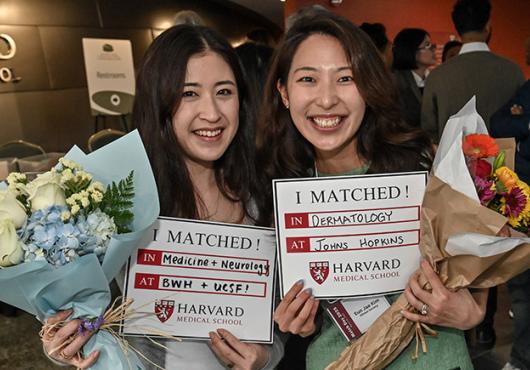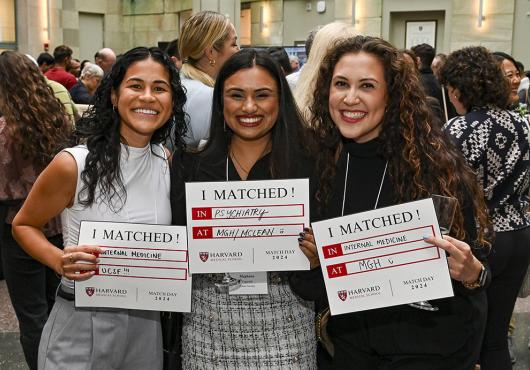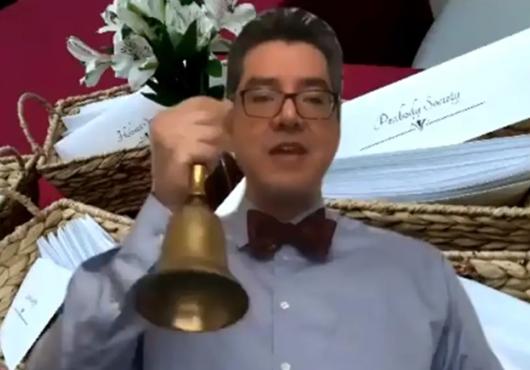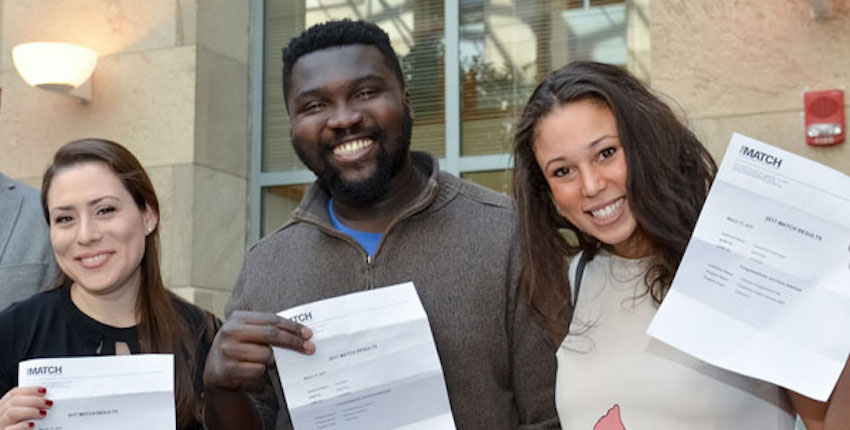
“Fortune favors the prepared mind.”
It’s a saying that is commonly attributed to Louis Pasteur, but it’s actually a simplified translation of what the famed scientist originally said in an 1854 lecture.
Nevertheless, the adage held true for the more than 150 Harvard Medical School students who learned on Match Day last week where they will spend the next three to seven years of their training.
View the related photo gallery
The students have been preparing for Match Day for four years—or longer, for those who took extra time to do a research year, obtain another graduate degree or add other pursuits to their MD training.
Over the years they have studied, acquired skills, worked with patients, rotated through specialties and prepared their residency applications.
“For me, Match Day is the culmination of all these four years. We’ve done so much work, had so many struggles, so many exciting times,” said Andrew Taliaferro, a Castle Society student, as he waited to pick up his Match envelope. “Finally we get to find out where we are going.”
Taliaferro participated in what is called a couples’ match, which allows students to request that they be matched together. He applied for the couples’ match with Peabody student Amy Le, who said that the pair was open to going anywhere and that no matter where they end up they are just “happy that we will be together.”
“Finally we get to find out where we are going.” —Andrew Taliaferro, Castle Society student
For some students, the anticipation was almost too much.
“About 15 minutes ago, when I was still at home, I almost passed out,” said Castle Society student Grace Chao. “I hope someone will catch me,” she said, anticipating what she would feel like when she opened her envelope.
Constructing careers
“Congratulations to everyone,” said Fidencio Saldaña, HMS dean for students. “As soon as Carla rings the bell, everyone go to your societies to get your matches,” he said. Traditionally, all medical students across the U.S. learn of their matches at the same moment—when the clock strikes noon EST.
When Carla Fujimoto, assistant director of student affairs, rang the bell, the TMEC atrium erupted in cheers of joy.
“We can’t wait to see what lies ahead for her,” said Maybell Campbell, a parent who attended the TMEC celebration with her husband, Ewen, to see where their daughter, Castle Society student Kirsti Campbell, matched.
Campbell matched at Brigham and Women’s Hospital in internal medicine.
“We are just very, very proud of her,” Campbell’s parents said.
Of the 167 graduating students in the HMS Class of 2017, 161 matched to training programs while six students will pursue nonclinical training. Internal medicine (43), emergency medicine (13), pediatrics (13) and anesthesia (10) were the most popular specialties.
While it is difficult to predict which students will eventually go into primary care versus specialty care, it is possible to extrapolate from the training categories the specialties that are related to primary care: 5 in family medicine, 43 in internal medicine, 13 in pediatrics and 8 in obstetrics/gynecology. Approximately 39 percent applied in primary care related fields.
Just over 50 percent, 84 of the 161 students, matched at an HMS affiliated program for a portion of their training, internship or residency. That includes 79 students who will stay in the HMS system to train at an affiliate location for their specialty only.
Design dreams
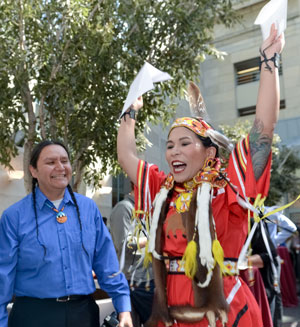
Los Angeles native and Holmes Society student Erica Kiemele was happy to be heading back home as she matched at the University of Southern California in emergency medicine. USC was Kiemele’s top choice.
Jason Packineau, with the Harvard Native American Program, worked with Kiemele from the time she was admitted to HMS, and Damon Clark, a Harvard College undergraduate, came out to support Kiemele.
Clark said he was excited for his friend.
“Do you know how many native doctors there are?” he asked. “It’s really important for the health of our tribal communities.”
“I want to work for the Indian Health Service,” Kiemele said. She plans to do her residency and then work on a reservation.
A plan for the future
Eighty-four of the 161 students matched to an HMS-affiliated program for a portion of their training, internship or residency. That includes 79 students who will stay in the HMS system, training at an affiliate location for their specialty only.
Braveen Ragunanthan, from Virginia Commonwealth University School of Medicine, joined in the HMS Match with his fiancée Nina Woolley, from the Castle Society.
“One more item for her list of great accomplishments,” said Ragunanthan, speaking of Fujimoto, who is retiring.
Fujimoto arranged with the National Resident Matching Program (NRMP) to have Ragunanthan’s match letter sent to HMS. The couple, who will be married in April, participated in the couples match and got their top choice in Pittsburgh, a match strategically located between where their parents live in Maryland and Northeastern Ohio.
As for Taliaferro and Le, the couple who met as first-year students and neighbors in Vanderbilt Hall and who later became anatomy lab partners, they will be heading off to San Francisco together, their top choice.
About matching
As part of NRMP, a system for placing medical school graduates in training positions at U.S. teaching hospitals, Match Day is held on the third Friday in March each year.
Match Day is the culmination of a process that begins each September, when both graduating medical school students and residency programs around the country register for the match. Throughout the academic year, students apply to and interview with the hiring programs.
Then, both students and programs submit their preferences, a rank-order list, by Feb. 22, and from there the NRMP runs its matching algorithm.
According to NRMP, this year’s match was the largest to date, with a record number of 35,969 U.S. and international medical school students and graduates vying for 31,757 positions, the most ever offered in the match.
The NRMP is a nonprofit organization that uses a computerized mathematical algorithm to align the preferences of applicants with the preferences of program directors in order to produce the best possible outcome for filling training positions available at U.S. teaching hospitals. The aim is to provide a fair, efficient, transparent and reliable process.
Triple celebration
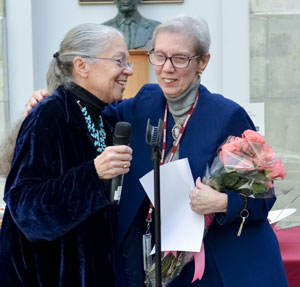
This year’s St. Patrick’s Day Match Day also celebrated the retirement of student affairs stalwart Fujimoto, who is retiring after 36 years of service to the School.
Nancy Oriol, former dean for students, presented a bouquet of flowers to Fujimoto.
“I’m here to celebrate Carla’s match, and she already opened her envelope,” Oriol said.
“I matched my couch,” said Fujimoto, joking.
Each year, the graduating students select an individual who will deliver a congratulatory toast to the matching students.
“We can’t think of anyone more fitting to give a toast,” said Holmes student Aaron Cohen as he introduced Fujimoto.
Fujimoto congratulated all the students and said that both she and this group of students are setting out on new journeys.
She reminded them that they came to medical school with dreams and aspirations, and although those dreams may have changed during their time at HMS, they still reflect the students’ core reasons for pursuing medicine.
“Take your dreams and put them in a special place in your heart, not very deep, but always accessible, so that when your days are hard and your nights are long you will remember your dreams, believe in your dreams, and never lose sight of how much good you will have a chance to do for your patients, for medicine and for our troubled world,” Fujimoto said.
